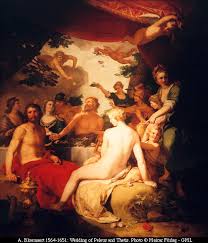Saturday, November 6, 2010
Dr. Katherine Wasdin : “Greek Gods at a Christian Wedding: Peleus and Thetis in Claudian carm. maior. 9”
DR. KATHERINE WASDIN
Rutgers University
“Greek Gods at a Christian Wedding: Peleus and Thetis in Claudian carm. maior. 9”
Abstract
Claudian’s epithalamium for the marriage of the emperor Honorius to his general Stilicho’s daughter Maria is prefaced by a 22-line elegiac introduction describing the marriage of Peleus and Thetis. This mythical union had long been an important paradigm for weddings in the Greco-Roman world, seen on vases and in literature (Reitzenstein). Thus it ought not surprise us that Claudian draws on the imagery of Peleus and Thetis. Yet there are several surprising factors at play in this use of myth: first, the choice of a pagan myth for a Christian emperor; second, the unique focus of this version of the myth; and finally, its connections to imperial propaganda. This paper shows that as a literary device, Claudian’s myth of Peleus and Thetis displays cultural capital via a link with the glorious past, but also that Claudian’s presentation of the myth is shaped by contemporary concerns as a coded message for court society.
The contrast between pagan and Christian is a curious phenomenon in fourth century art and literature. With few exceptions, Christian artists and patrons seemed to have been comfortable using their pagan past in public settings to signify elite literary knowledge. For example, Claudian’s poem can be easily compared with the silver wedding casket for Proiecta and Secundus now in the British Museum, on which the Christian couple is combined with mythical decoration of marine Venus. Claudian’s own religious sentiments remain shrouded, but it is clear that, although the court was firmly Christian, it had no objections to being praised in connection with pagan imagery, seen as culturally appropriate for high art.
The language Claudian uses to describe this myth shows it as a political choice that is marked in context. Instead of discussing the meeting, courtship, and actual marriage of Peleus and Thetis, Claudian adapts the myth for court society by describing only the gathering of gods for celebration in a natural fantasia. The opening verses present not the couple, but rather Nereus as socer aequoreus, the watery father of the bride. His prominent placement is due to the central role that the real-life father of the bride, Stilicho, played in Claudian’s poetry, and his epithet possibly alludes to Stilicho’s use of ships to transport troops. Furthermore, though the real-life groom, Honorius, had higher rank than the Vandal Stilicho and his daughter, the mythical bride is in fact a queen, clearly marked as reginam Thetim in the final verse of the poem. Thus Maria comes in for high praise via her mythical doppelganger, whereas the groom is not even mentioned by name. Claudian also borrows from Catullus and other authors Apollo’s prophecy of Achilles said to have taken place at the wedding. Yet instead of an ominously bloody and ultimately disheartening warrior, his Achilles is a proud link in the imperial chain. This would be particularly appropriate here, as any fruit of this union would add to Stilicho’s claim for rule.
The refocusing of the traditional paradigm to represent political hierarchy shows how society draws from and influences the representation of myth, whether or not it is part of contemporary religion or belief. Myth clearly played a constructive function in Late Antique court society, as this romantic test case makes clear. In an almost circular fashion, Claudian uses his modified myth of Peleus and Thetis to create the "myth" of Honorius and Maria as a productive and naturally godlike couple inherently linked with Stilicho’s regime. By means of the allegorizing and timeless poetic world of Claudian’s myth, traditional wedding imagery becomes Stilichonian propaganda, recreated for his political ends as a message for those at court, be they friends or foes.
Subscribe to:
Post Comments (Atom)

No comments:
Post a Comment